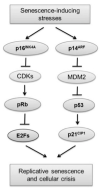Cell Immortalization: In Vivo Molecular Bases and In Vitro Techniques for Obtention
- PMID: 36810441
- PMCID: PMC9944833
- DOI: 10.3390/biotech12010014
Cell Immortalization: In Vivo Molecular Bases and In Vitro Techniques for Obtention
Abstract
Somatic human cells can divide a finite number of times, a phenomenon known as the Hayflick limit. It is based on the progressive erosion of the telomeric ends each time the cell completes a replicative cycle. Given this problem, researchers need cell lines that do not enter the senescence phase after a certain number of divisions. In this way, more lasting studies can be carried out over time and avoid the tedious work involved in performing cell passes to fresh media. However, some cells have a high replicative potential, such as embryonic stem cells and cancer cells. To accomplish this, these cells express the enzyme telomerase or activate the mechanisms of alternative telomere elongation, which favors the maintenance of the length of their stable telomeres. Researchers have been able to develop cell immortalization technology by studying the cellular and molecular bases of both mechanisms and the genes involved in the control of the cell cycle. Through it, cells with infinite replicative capacity are obtained. To obtain them, viral oncogenes/oncoproteins, myc genes, ectopic expression of telomerase, and the manipulation of genes that regulate the cell cycle, such as p53 and Rb, have been used.
Keywords: Hayflick limit; alternative telomere elongation; immortalization; telomerase; telomeres.
Conflict of interest statement
The authors declare no conflict of interest.
Figures




Similar articles
-
Telomere length maintenance in aging and carcinogenesis.Int J Oncol. 2000 Nov;17(5):981-9. doi: 10.3892/ijo.17.5.981. Int J Oncol. 2000. PMID: 11029502 Review.
-
Telomeres, telomerase, and myc. An update.Mutat Res. 2000 Jan;462(1):31-47. doi: 10.1016/s1383-5742(99)00091-5. Mutat Res. 2000. PMID: 10648922 Review.
-
[The role of telomere-binding proteins in carcinogenesis].Minerva Med. 2000 Nov-Dec;91(11-12):299-304. Minerva Med. 2000. PMID: 11253711 Review. Italian.
-
Telomere control of replicative lifespan.Exp Gerontol. 1997 Jul-Oct;32(4-5):375-82. doi: 10.1016/s0531-5565(96)00164-7. Exp Gerontol. 1997. PMID: 9315442 Review.
-
Telomerase activity in human cancer.Curr Opin Oncol. 1996 Jan;8(1):66-71. doi: 10.1097/00001622-199601000-00012. Curr Opin Oncol. 1996. PMID: 8868103 Review.
Cited by
-
White Light Spectroscopy Characteristics and Expansion Dynamic Behavior of Primary T-Cells: A Possibility of Online, Real-Time, and Sampling-Less CAR T-Cell Production Monitoring.Biosensors (Basel). 2025 Apr 15;15(4):251. doi: 10.3390/bios15040251. Biosensors (Basel). 2025. PMID: 40277564 Free PMC article.
-
The effects of immortalization on the N-glycome and proteome of CDK4-transformed lung cancer cells.Glycobiology. 2024 Apr 24;34(6):cwae030. doi: 10.1093/glycob/cwae030. Glycobiology. 2024. PMID: 38579012 Free PMC article.
-
Establishment and characterization of the first immortalized vocal cord leukoplakia epithelial cell line.Cancer Gene Ther. 2025 Jan;32(1):95-103. doi: 10.1038/s41417-024-00859-4. Epub 2024 Nov 23. Cancer Gene Ther. 2025. PMID: 39580588 Free PMC article.
-
Scaling Cultured Meat: Challenges and Solutions for Affordable Mass Production.Compr Rev Food Sci Food Saf. 2025 Jul;24(4):e70221. doi: 10.1111/1541-4337.70221. Compr Rev Food Sci Food Saf. 2025. PMID: 40635127 Free PMC article. Review.
-
Conditional Immortalization Using SV40 Large T Antigen and Its Effects on Induced Pluripotent Stem Cell Differentiation Toward Retinal Progenitor Cells.Stem Cells Dev. 2025 Jan;34(1-2):26-34. doi: 10.1089/scd.2024.0124. Epub 2024 Nov 29. Stem Cells Dev. 2025. PMID: 39611948
References
Publication types
LinkOut - more resources
Full Text Sources
Research Materials
Miscellaneous
